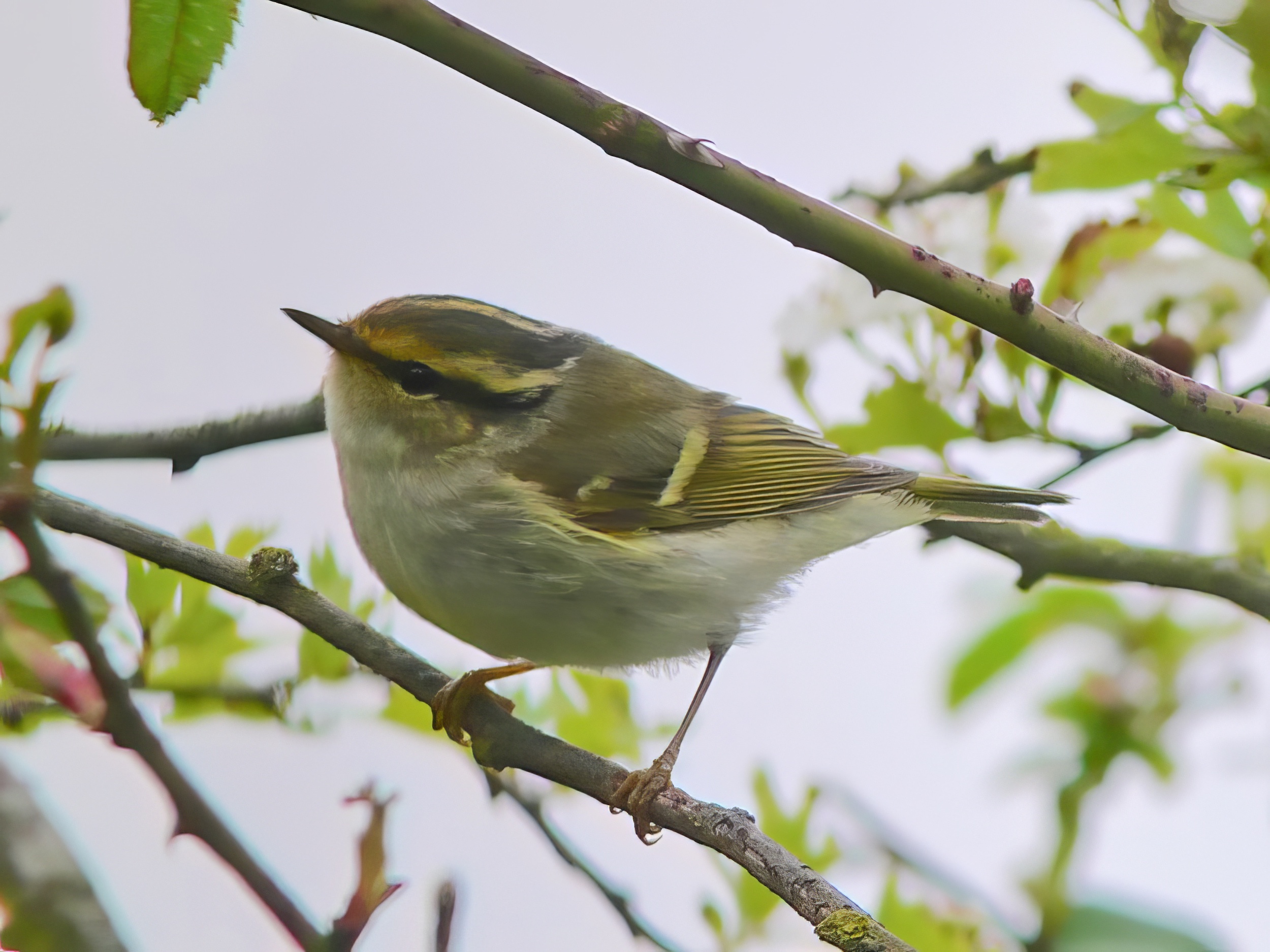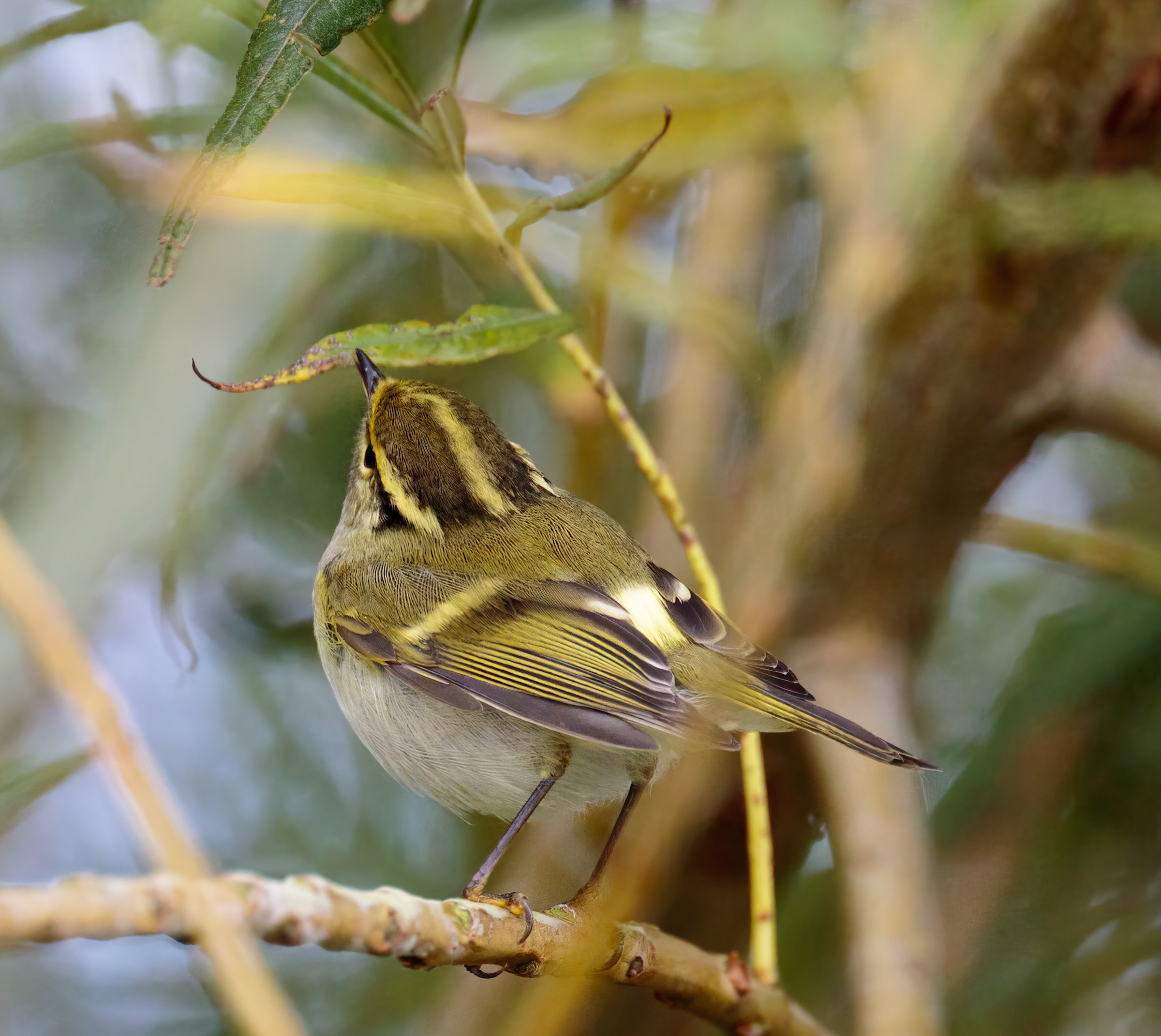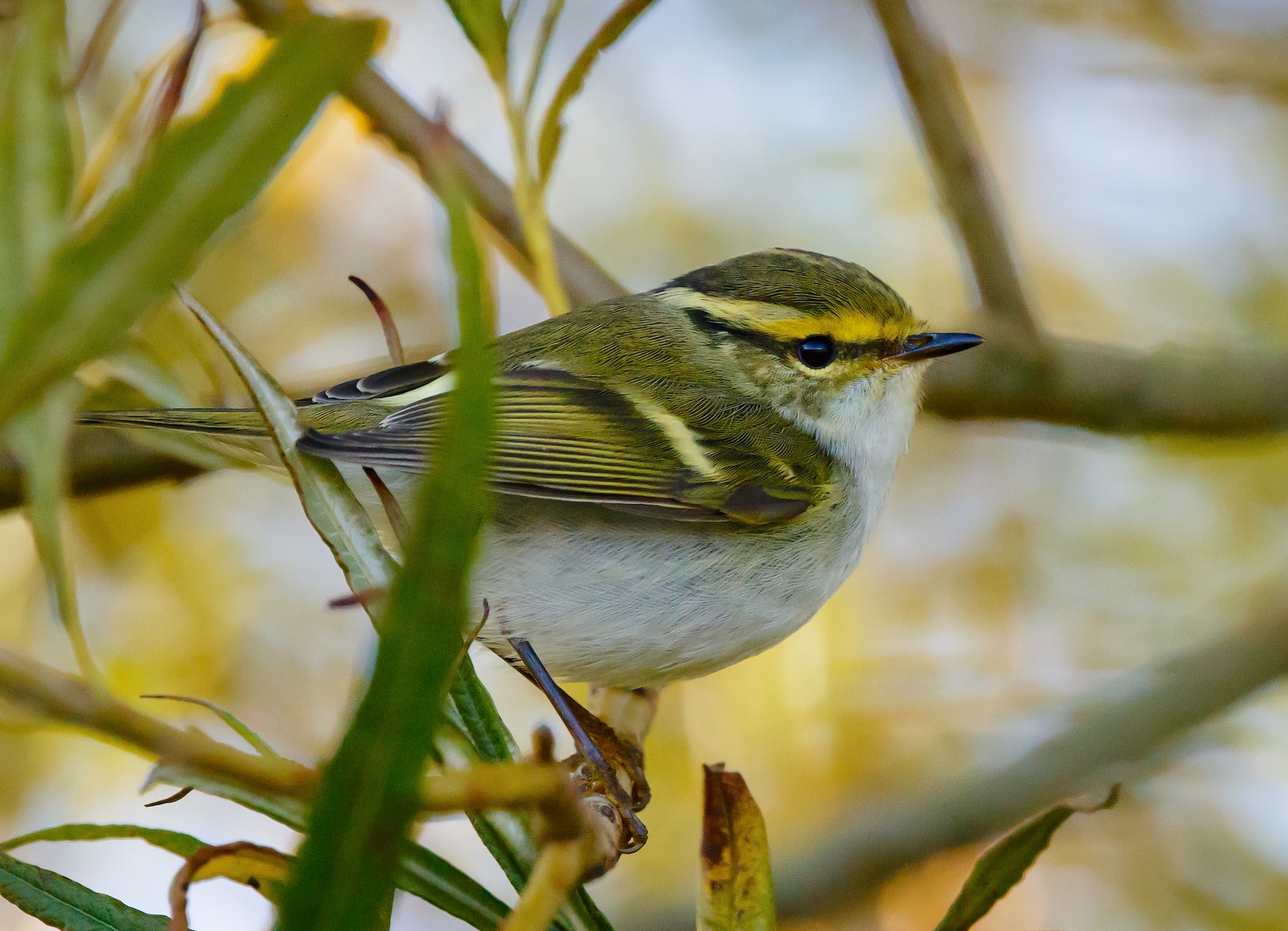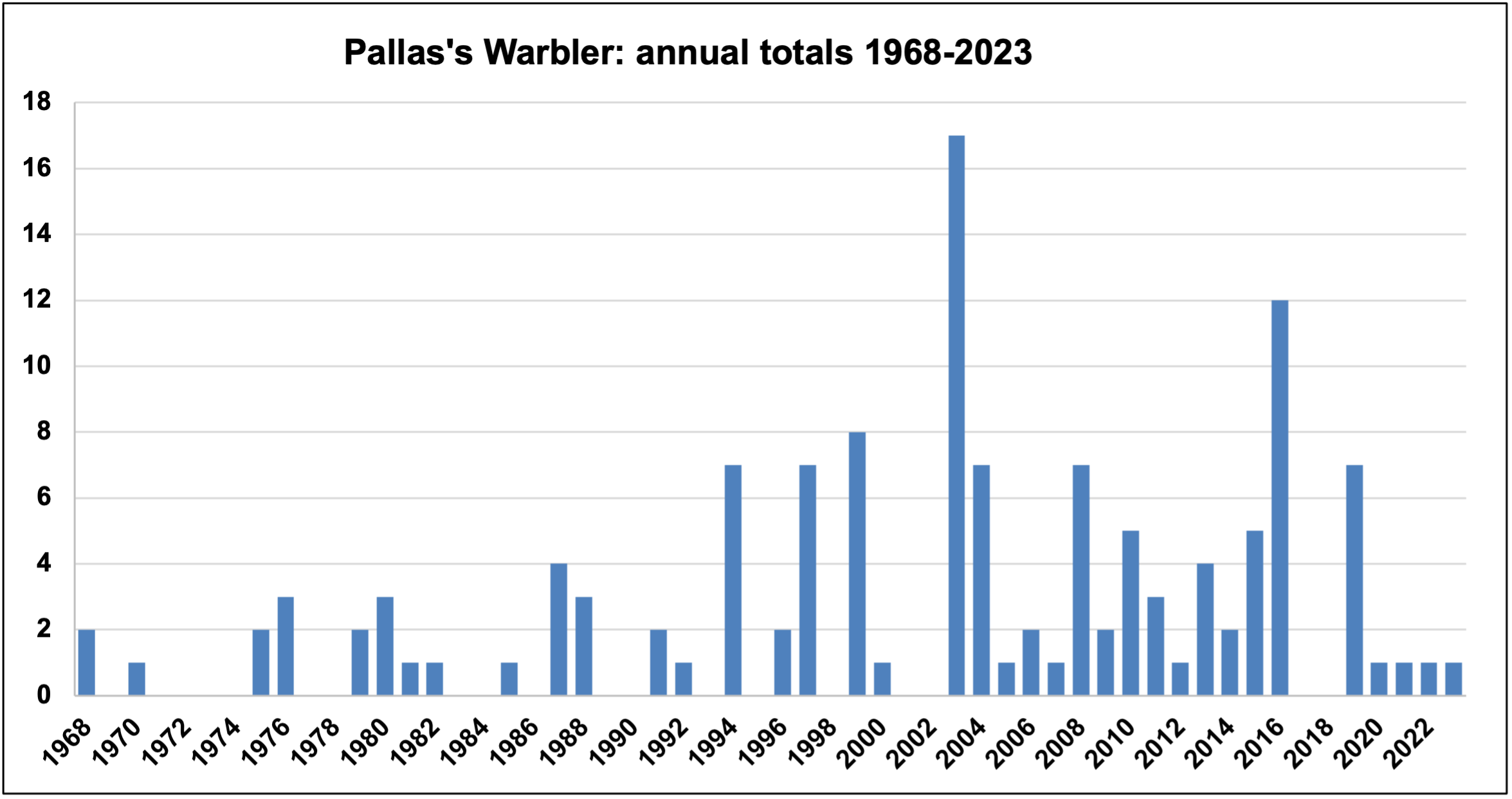Pallas's Leaf Warbler Phylloscopus proregulus
Very scarce but increasing passage migrant September-November, rare inland. Siberia.



First recorded on October 19th 1968 when there were singles at Anderby Creek and Gibraltar Point NNR, this species has become much more familiar to birders but it arguably remains one of the great pleasures of an easterly autumn to come across one hovering on the edge of a coastal sycamore hawking as many insects as it can find. Occurrences since 1968 have been patchy but generally show an upward trend with six or more records in several years and peaks of 17 in 2003, 12 in 2016 and seven in 2019. Of particular interest was the autumn of 2003 (chart below) in Britain when there was a record arrival of both Pallas’s (303) and Yellow-browed Warblers, P. inornatus (853). Surprisingly in view of their increased status in Britain, there were blank years in Lincolnshire in both 2017 and 2018. The peak arrival period in Lincolnshire for these amazing little warblers tends to be October 11th-31st with a significant minority going into November. The extreme dates for the county in autumn are October 7th, 2016 and November 24th, 2019. There has been a single record of a spring bird: a male found singing at Freiston Shore May 7th, 2007. This was one of two spring records that year, the other being in Kent, the third and fourth spring records in Britain at the time.

Finder’s reports: Pallas’s Leaf Warbler, October 19th, 1968, at Anderby Creek and Gibraltar Point NNR, first county records.
by K. Atkin and R. Pearson.
Note: this account is taken from the original submissions to the RC and are the first county records. The RC noted that Pallas’s Leaf Warblers had been recorded only once before 1951 and only seven times up to 1962; then came six in 1963, one in 1964, four in 1965 and three in 1966. Now, after a blank in 1967, there was this astonishing influx of 18 in eight counties, ten of which were trapped and ringed. All were on the east and south coasts from Aberdeen to the Isles of Stilly and Co. Cork (14 between Yorkshire and Sussex) and all during 18th-30th October; the grand total thus jumped from 20 to 37 within 13 days.
Circumstances
Pallas’s Leaf Warblers were trapped more or less simultaneously in the dunes at Anderby Creek (at 12.15 hr.) and at Gibraltar Point (at midday). The weather was fine with sunny periods with a moderate E/ESE wind. The bird at Gibraltar Point called several times when in the hand, a high-pitched rising, double note “chee-wee”. Communication between the ringers involved saw both birds examined at Huttoft before the Gibraltar Point bird was returned whence it came and released; it was given ring number PH3338. It was noted that when released, the Anderby Creek bird flew directly and very fast into thick cover, the yellow rump being most striking as it flew away. As it moved actively through some Elder bushes its small size, prominent supercilium and prominent wing bars were the most distinctive features.
Description
Detailed descriptions of both birds were taken by the observers, which were essentially the same, and a combined summary is given below:
Size – very small, smaller than a Willow Warbler.
Head – crown olive-green to dark green becoming blackish towards the nape; central yellow stripe running from nape along centre of the crown to within 5mm. of the base of the bill. Long, broad yellow supercilium, brighter than the central crown stripe, and reaching almost to nape, and bridging across the forehead; brightest in front of eyes and on forehead. Long dark line from the bill, where it was olive, and through the eye, broadening and blackish behind the eye. Cheeks mottled pale yellow and green becoming yellower between bill and eye and darker on ear coverts.
Upperparts – mantle, back and uppertail coverts predominantly bright green, darkening on the nape to blackish and becoming speckled with the start of the head stripe and superciliary. Rump, up to 7-8 mm. wide, bright yellowish-white contrasting with, and sharply defined from rest of back. Narrower and whiter in centre compared with broader yellow sides. Tail dark blackish-brown (RP) or dull green, darker than back with bright green outer edges (KA).
Wings – primaries, secondaries and tertials brownish to brownish-black with bright greenish edges on outer webs and white spots on the tertials. Lesser coverts bright green, similar to upperparts. Greater coverts tipped creamy-yellow forming a very distinct wing-bar. Median coverts tipped creamy-yellow giving appearance of a small wing-bar but as distinct as that on greater coverts. Tertials creamy-yellow on tips similar to greater coverts but colour extending part way up outer edges of the feathers.
Underparts – underwing silvery-grey, coverts streaked yellow, yellow at bend of wing. Chin, throat, breast, and belly whitish with faint yellowish wash and flanks streaked yellow.
Bare parts – legs dark brown, feet brown above, yellow below. Eyes blackish, mouth yellow. Bill small but rather strong-looking, blackish with pink at base of upper mandible (KA) or horn-coloured on inner third of lower mandible (RP).
Biometrics
| Variable | Gibraltar Point bird | Anderby Creek bird |
| Wing length (mm) | 51 | 48 |
| Weight (g) | 5.75 | 5.0 |
| Tail (mm) | 38.5 | 35 |
| Bill (mm) | 9 | 9 |
| Tarsus (mm) | 15.5 | 15.5 |
| Emargination of primaries | 3-6 | 3-6 |
| Wing point | 4th and 5th primaries | 4th and 5th primaries |

